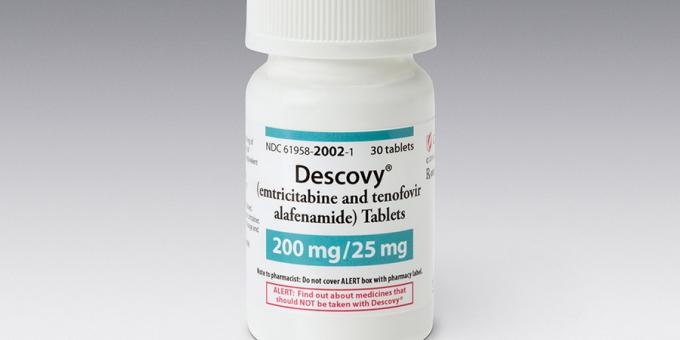

Now we know for sure—Descovy was found to be just as good as Truvada for preventing HIV.
That’s good to know, but how important is it?
The idea, of course, is that Descovy, the newer and kinder version of Truvada, would be safer to use for HIV PrEP (pre-exposure prophylaxis, or prevention).
Back in 2012, Truvada was a well-established HIV medication when it was approved by the FDA for preventing HIV infection in the first place. Today, it is considered 99% effective against HIV when taken as prescribed.
Then in 2016, the FDA approved a newer version of Truvada that’s safer on the kidneys and bones, Descovy. But you couldn’t take Descovy for PrEP, because the research wasn’t there.
The DISCOVER study results presented at CROI showed that of a large number of people put on either Descovy or Truvada for PrEP who were truly at high risk for HIV, almost none became infected with the virus. (See sidebar below, “The DISCOVER Trial Data at One Year.”)
When comparing these individuals to a similar group not in the study but who had similar risks, however, you could see how truly effective both drugs are at preventing HIV infection.
Moreover, the high rate of STIs in the study was a clue that way more than 22 people would have become HIV-positive had they not taken the prevention medicine. Half of all individuals in the study had at least one STI, whether they were given Descovy or Truvada.
Does it make a difference now that Descovy can be taken for PrEP instead of Truvada? (In April, Gilead Sciences filed a supplemental New Drug Application [sNDA] with the FDA for Descovy for PrEP. If approved, this would mean a new use—called “indication” in the medical world—for Descovy.)
Yes, said Jenna Wimmer, a nurse practitioner from Howard Brown Health’s clinic at TPAN, in Chicago. “For some older patients, who may have renal problems, it makes a difference,” she said.
As usual, there are pluses and minuses to using a newer drug.
“Another once-a-day HIV prevention pill that’s effective and well-tolerated?” said activist Jim Pickett. “That doesn’t make me excited. An effective and well tolerated implant? That makes me excited. An effective and well-tolerated microbicide [inserted vaginally or anally]? That makes me excited.” There are a number of ways that HIV PrEP can work, as he pointed out.
In terms of safety, side effects are more important for people using Descovy or Truvada long-term, as with HIV therapy. At this point in time, HIV treatment is meant to be lifelong. So, a small difference in safety may be important for people on HIV therapy.
PrEP, however, is often discussed in terms of “seasons of risk.” For example, when someone is in a non-monogamous relationship, or is dating in hopes of finding a committed relationship.
Study presenter Brad Hare, MD, Chief of Infectious Diseases at Kaiser-Permanente, San Francisco, continuously fielded questions about the safety advantage of Descovy for PrEP.
“Our study did not have enough clinical outcomes either in the renal or the bone arenas to identify a difference between the two,” he said in a press conference. “Both of those are so uncommon in these young, and in our study population, relatively healthy population. I think it’s reassuring to know that both of these drugs actually do pretty well in terms of safety in this population. Whether we’ll ever know if there’s a clinical difference in outcomes would require a huge number of people and a long time of observation.”
The difference in drug discontinuation for renal issues or any other adverse event with the two medications was not statistically significant, he said.
Another point to consider is that Truvada is expected to come off patent in another year or so. That means a cheaper generic version can be made available. Insurance payors might even insist on that version being used for PrEP. (A generic has been approved by the FDA, but is not commercially available.)
There may be, however, certain groups for whom Descovy would be preferred. Those with pre-existing kidney or bone problems, for example.
There’s a seemingly never-ending search for better options. Just how much better Descovy for PrEP may be over Truvada remains to be seen.
By the numbers
DISCOVER trial data at one year
The demographics
- 5,387 individuals enrolled, from the United States (60%), Canada (7%), and Europe (34%). 94 sites from 11 countries participated.
- High risk for sexually acquired HIV required for entry into the study, defined as:
- 2 or more episodes of condomless anal sex in the previous 12 weeks or
- 1 episode of syphilis or of rectal infection of gonorrhea or chlamydia in the previous 24 weeks
- Other HIV risk factors included recreational drug use within the past 12 weeks and binge drinking (defined as having at least six drinks on one occasion, every month)
- At least 60 eGFR (estimated glomerular filtration rate), a measure of kidney function, was required for participation
- Ages 18–76 (half were under age 34)
- White (84%), black (9%), Asian (4%), Hispanic or Latinx ethnicity (25%)
- Transgender women: 45 on Descovy (2%); 29 on Truvada (1%); all other participants were men who have sex with men (MSM)
The study
- 2,694 were put on Descovy (one pill a day)
- 2,693 were put on Truvada (one pill a day)
- All given an extra placebo pill to take so they wouldn’t know whether they had been given Descovy or Truvada
- Other prevention services provided included risk reduction counseling, condoms, and lube
The results
- At 48 weeks, 2,242 remained on Descovy (83%) and 2,263 remained on Truvada (84%)
- Most frequent reasons for dropping out of the study were: withdrawal of consent; moved; monogamous relationship; reduced sexual risk; and obligations related to work, school, or the military.
- 7 HIV infections on Descovy: 1 suspected infection at baseline; 5 with low levels of medication; 1 with medium level of medication. 15 HIV infections on Truvada: 4 suspected infections at baseline; 10 with low levels of medication; 1 with high level of medication. The difference in infection rate between Truvada and Descovy was not statistically significant.
- Compared to CDC surveillance data on HIV risk for MSM (more details at croiconference.org), the infection rate was:
• 4.02 per 100 person years (PY) for MSM not on PrEP
• 0.45 per 100 PY for DISCOVER participants on Truvada
• 0.08 per 100 PY for DISCOVER participants on Descovy
- Side effects: Both were found to be safe and tolerable. However, two of the individuals taking Descovy and six who were taking Truvada discontinued the medication due to renal issues. One person on Truvada developed Fanconi syndrome (a kidney-related malfunction).


